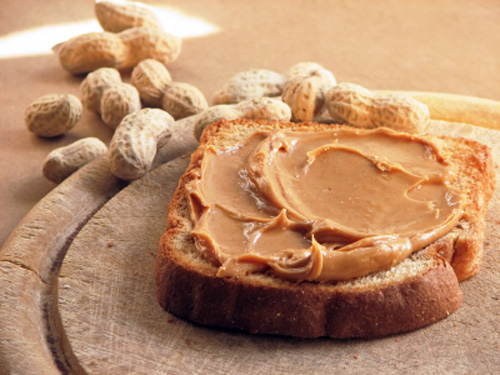
Written By: Beth Ehrensberger, RD
Title: Registered Dietitian
Alumni: University of Tennessee, Knoxville
Last Updated on:

It turns out that mom had it right all along… a plain old peanut butter sandwich can be part of a healthy lunchbox meal. Portable, inexpensive and protein packed – pair a peanut butter sandwich with an apple and you’ve got a healthy lunch! Unfortunately, peanut butter has a bad reputation for being full of fat – so it’s often crossed off the conscientious shopper’s list.
It’s no secret that peanut butter is a food to eat in moderation. Even Elvis discovered that too many of his beloved grilled peanut butter and banana sandwiches could widen the waistline. Because it’s made from nuts, peanut butter is high in fat (even though most of it is healthy fat) and calories, so a little goes a long way. A one-ounce serving of peanut butter is one level tablespoon, which can be visually estimated as the tip of a woman’s thumb.

Table of Contents
What makes peanut butter a healthy choice? Not many other foods can boast peanut butter’s versatility – it provides a dose of carbohydrates for an energy boost, bundled with the long-lasting satisfaction and full-feeling caused by protein and fat.
Even the fat in peanut butter is beneficial. Most of it is monounsaturated – heart-healthy fat that lowers total cholesterol and LDL (bad cholesterol), while boosting HDL (good cholesterol). Add the benefits of Vitamin E, fiber, niacin, phosphorus, and magnesium – all of which you’ll also find in peanut butter – and you’ve got a simple but super-healthy food. With all these great qualities, no wonder peanut butter was trusted to fuel hungry soldiers as part of US Army rations during WWII.
Recently, there’s been a lot of debate about whether “natural” peanut butter is better than the old stand-by. A recent study by the United States Department of Agriculture suggests that there is no reason outside of personal preference to recommend natural over regular peanut butter, since the testing showed an undetectable amount of trans fat in both samples. Samples tested represented eleven commercial peanut butter brands (regular and natural) in addition to freshly ground peanut paste. Both natural and regular peanut butter are healthy choices – as long as you are careful to stop spreading at one serving.
Peanut butter is almost always a staple in grocery carts when it comes to back to school shopping. Try these healthier twists on an old favorite for your family’s back to school meals:
Try blending up a quick smoothie by mixing icy cold skim milk, half a ripe banana, and a tablespoon of peanut butter. It’s a protein-packed breakfast that can be sipped on the way to school or at the bus stop.
Notch up the fiber by making a classic PB and J without the J – use apple slices instead. You can add even more satisfying fiber by using whole wheat bread instead of plain white.
Spread a thin layer of peanut butter on a couple of whole wheat graham crackers for a healthy snack that will keep everyone satisfied until dinner.
Peanut butter has a place in a healthy diet. An easy, inexpensive protein source that is brimming with nutrition, peanut butter is a simple, versatile food. Just be sure you enjoy peanut butter in moderation, since it’s high in fat and calories, too. One serving of regular smooth peanut butter (1 Tbsp) provides about 95 calories with 4 grams of protein and 8 grams of fat.
Alumni: University of Tennessee, Knoxville – Beth Sumrell Ehrensberger is a Registered Dietitian and holds a Master Degree in Public Health. An experienced nutrition counselor, writer and public speaker, Beth specializes in translating complex nutrition information into practical concepts. Beth was awarded a Nutrition Communications Fellowship to the National Cancer Institute, and has worked on the internationally recognized Nutrition Action Healthletter of the Center for Science in the Public Interest.